












ince 2012, the U.S. Department of States’ OneBeat program has welcomed hundreds of young international musicians to the United States to learn, share and create great music together.
Initiated by the Department’s Bureau of Educational and Cultural Affairs the program is produced by Found Sound Nation, an arts nonprofit organization based in New York City. OneBeat was created to help young musicians learn about other cultures and build powerful connections across borders, and languages.
In late 2022, 25 musicians and former OneBeat participants from 15 countries participated in OneBeat X, the creative gathering’s 10th anniversary celebration.
SPAN connected with innovative Indian musicians Gowri Jayakumar, who participated in OneBeat X, and Sumukh Mysore, who was part of OneBeat 9 in April-May 2022, to learn about their experiences.
Jayakumar is a Goa-based curator, music producer and D.J. who works under the name Pulpy Shilpy. She describes her style of music as “raw, sensual, nervous energy.” Mysore, who performs under the name Smokey the Ghost, is a Bengaluru-
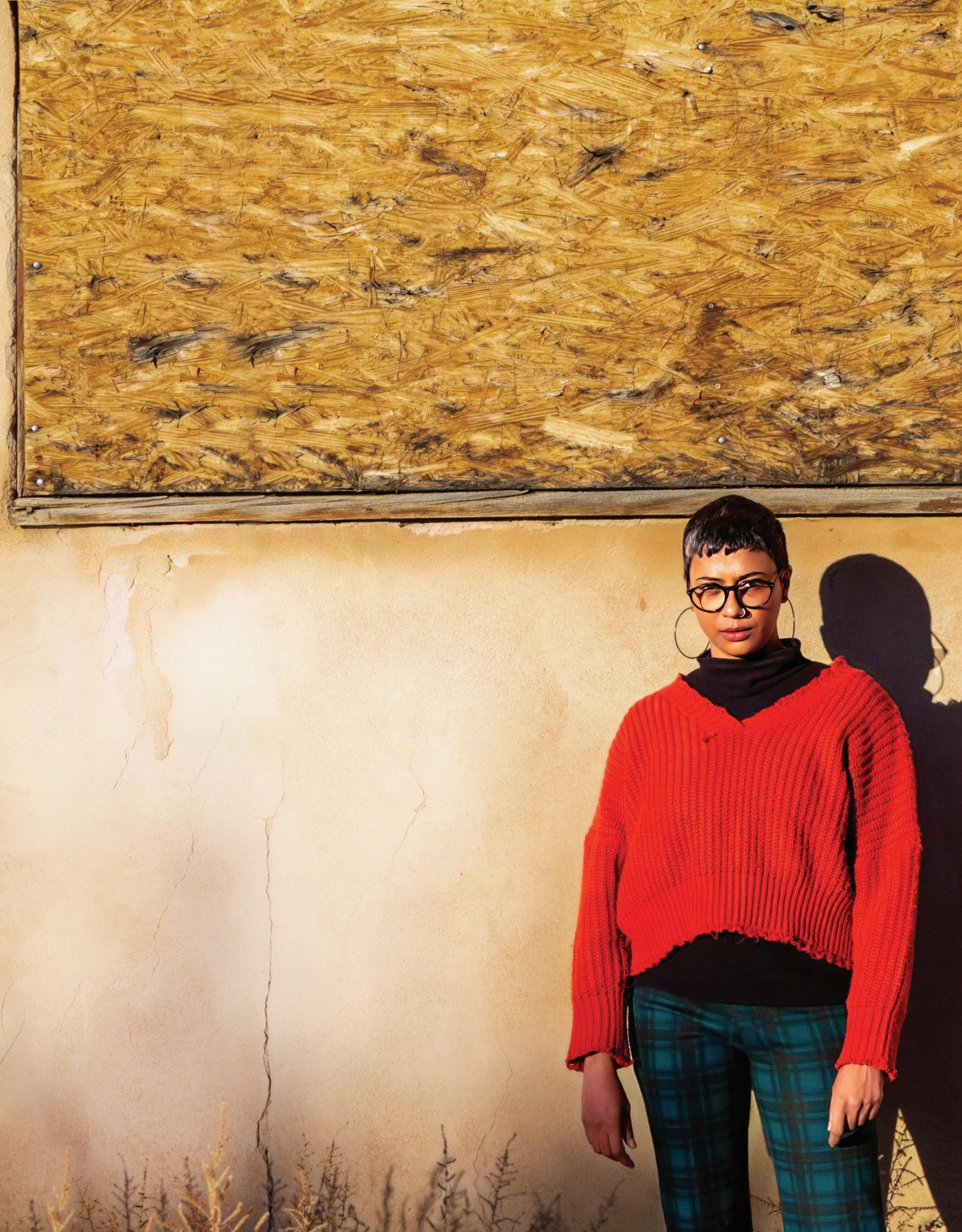
based rapper who “makes protest music, through and through,” he says.
Both artistes say they were thrilled to join OneBeat’s vibrant and creative community and connect with musicians from different countries and cultures.
OneBeat X took place in October 2022 in Taos, New Mexico, for three weeks. Together, the musicians learned about New Mexico’s history and culture, shared stories inspired by the area’s natural environment and built collaborative musical works inspired by these conversations. In partnership with local schools and community organizations, the musicians concluded OneBeat X by sharing their works through public performances, discussions and other events. In Albuquerque, New Mexico, for example, OneBeat X musicians created a half-day public festival, which included art installations and live concerts.
From first meetings to final performances, Jayakumar was deeply inspired by other OneBeat X participants. “It was humbling to be among such incredible artistes,
OneBeat
https://1beat.org







https://1beat.org/people/ pulpy-shilpy
many of whom are masters at their crafts, but ever so generous with their knowledge,” she says. “For the first time in many years, I felt a sense of collective thought, of belonging, of what it means to nourish and empower a community.”
For Mysore, the experience of attending OneBeat 9 in Florida was just as uplifting. “I went in thinking about how many songs I was going to make and how to make my music good, but for the first few days, we mostly just got to know each other,” he says.

Even though he felt overwhelmed at the beginning, he soon saw the experience as “a very calming way of changing my mind in a good way,” he says. “Being with everyone at OneBeat focused me very positively, and I did not expect that to happen!”
Long after the final notes of their OneBeat experiences faded away, Jayakumar and Mysore continued to make its echoes heard around the world. “Those three weeks were like a much needed escape to fantasy,” says Jayakumar. “It is rewiring my brain,
my chemistry, and only time will tell how these epiphanies and experiences will manifest.”
Jayakumar hopes to organize a future OneBeat gathering—or something just as fun, musical and inspiring—in India. “I hope we are instrumental in making that happen soon, and open the floor to ideas, collaborations and funding,” she says.

For Mysore, “community is more important than anything else,” he says. “The United States is a mecca for hiphop, and after being part of OneBeat, I took back knowledge to share with my community of rappers in India.”

“Bengaluru is a start-up city,” he continues, “and I plan to start an accelerator for hip-hop that educates and supports the community. I hope it will help give rise to the next biggest rapper in India.” For musicians and performers anywhere who want to participate in future OneBeat festivals, Jayakumar has bold advice. “Just apply,” she says. “Be yourself, dream big, document your work and go for it.”
Michael Gallant is a New York City-based writer, musician and entrepreneur.
As a “socio-conscious” rapper, Smokey the Ghost uses his music to explore social, cultural and political issues that can be controversial and difficult to talk about. “I recorded one song called ‘Baldest of the Bald’ that addresses the stigma of losing your hair,” he describes. “In India, going bald means somebody died or something really bad happened, or that you’re never going to be attractive. My song explored the patriarchal pressure that tells men that they should be ashamed of going bald, and that they can’t talk about these things.” The song got great feedback, he says, “and many men told me that I was saying things that they’d wanted to say for a long time but felt like they couldn’t.”
Pulpy Shilpy began her career as a journalist, but started to pursue music full time after winning a small scholarship to a music school. “As a songwriter, a lot of the writing I’d done as a businessjournalist helped,” she says. “I focused on crisp, coherent lyrics— nothing too long, but plenty playful.” She describes the music she writes as mostly “clear, to the point, and efficient in delivery.”
However, for the past few years, “as I’m getting older, I’m gravitating toward ambient, minimal, expansive sonic spaces, as I am keen on getting lost in there, rather than finding my way,” she adds. —M.G.




 By MONISA NADEEM and KRITTIKA SHARMA
By MONISA NADEEM and KRITTIKA SHARMA



Karan Desai was 8 years old when he first started reading comics. “I started collecting them in 2002, when they were priced at Rs. 20 or Rs. 25,” he says. His first loves were Batman and Superman. Now, 20 years later, he may have lost his original comic book stash and moved on from Batman and Superman to Doctor Strange, but the influence of these childhood characters has shaped how he views the world. Desai has Bell’s palsy, which has led to facial paralysis on the left side. He identifies with the way the fictional Doctor Strange works around the nerve damage in his hands. “I’ve been learning to struggle and improve from that,” he says. Desai made his own Doctor Strange costume and has been using it for cosplay for the past seven to eight months.
 Karan Desai (right) cosplayed as Doctor Strange at the New Delhi Comic Con (above) in December 2022.
Karan Desai (right) cosplayed as Doctor Strange at the New Delhi Comic Con (above) in December 2022.
For a lot of Indian kids born in the 1980s, comic books and American superheroes like Superman and Batman have been an integral part of growing up. Many carried on their love for their favorite superheroes for several years, and gave it a stage to play out at the Delhi Comic Con. From cosplays, comic book and figurine collections, to more deep-rooted influences, it was evident that American superheroes hold a special place in the hearts of old and new DC and Marvel fans.

Sakshi Singh, who came from Varanasi to attend the Comic Con, is a huge fan of feminine superheroes like Buffy from “Buffy the Vampire Slayer,” and Shuri and Wanda from the Marvel Cinematic Universe. For her, Buffy is the ultimate mascot for women’s empowerment. “Buffy is a strong character,” says Singh. “She is not only a superhero because she has supernatural powers, she is also emotionally strong and has a femininity that makes her iconic.”
Most importantly, says Singh, Buffy portrays none of the machismo that some of the male superheroes do. “She sees emotion, she goes through stuff, she develops and matures and grows in her own character and that’s what makes her very special,” she adds.




As standalone characters of the maledominated Marvel Cinematic Universe, Shuri and Wanda also bring unique narratives to the superhero storylines. “I know Wanda is right


now going through certain things, and we need not categorize her as a superhero. But I think Wanda’s character is a rich representation of how people go through mental trauma, and it makes them the superhero. When we see that they are also struggling and reacting in a very human way, it makes us feel closer to them.”



The relatability is what draws several fans to hang on to their childhood superheroes, well into their adult life. For Desai, the comic books were “like the idols that you get when your parents aren’t fully there” while growing up.





“As I’ve grown, I’ve understood the complexity of the characters. It is not just black and white, good and bad. There’s a lot more going on—it’s been a much more educated experience right now,” says Desai. Even Dhruv Kalra, the 20-year-old who cosplayed as Spiderman at the Comic Con, takes Uncle Ben’s iconic dialogue—with great power comes great responsibility—very seriously. But what kind of value can a fictional character add to someone’s life?



“The way I want to live my life is that in future I don’t want any regrets,” says Prince Mahajan, the 23-year-old who visited the Comic Con dressed as himself—a superfan. “I want to believe that whatever I did in that moment, I thought about it, and it was the right thing to do then. And that’s how Captain America influences me. He sees the whole picture.”
 Below: The New Delhi Comic Con saw fans of all ages and interests. Dhruv Kalra (center) a 20-yearold, came to the event dressed as Spiderman.
Below: The New Delhi Comic Con saw fans of all ages and interests. Dhruv Kalra (center) a 20-yearold, came to the event dressed as Spiderman.
As I’ve grown, I’ve understood the complexity of the characters. It is not just black and white, good and bad.
Three American diplomats discover Delhi in their personalized autorickshaws—one honk at a time.
Don’t be surprised the next time you spot an autorickshaw with a diplomatic number plate weaving through Delhi traffic. It is possibly one of the American diplomats who have taken a fancy to the ubiquitous three-wheeler and drive around the city in their beloved “tuk-tuks.”

Ann, Shareen and Ruth bought three-wheelers to experience the capital in all its uniqueness. They have taken this quintessential mode of public transport and turned it into a personal vehicle of choice.
Ann has taken special care to personalize her autorickshaw, nicknamed KITT, in homage to the 1980’s show “Knight Rider.” She has been driving
By KRITTIKA SHARMAKITT for the past two years, adding accessories to the vehicle, which is now an extension of her personality.
“KITT is all about the bling,” says Ann. She has chosen an all-black auto that has doors on both sides of the passenger seats. The passenger seat is protected by two special high-speed leopard print curtains on each side. For her own convenience, she has placed a small fan next to the steering unit and a portable bluetooth speaker in the overhead space, giving her the music she needs. “I also have a little tissue box for my guests and a little phone holder so that I know where I am. Because I am always lost,” she says with a straight face.
Top to above: Shareen has painted her auto an attractive pink, with the flags of the United States and India flanking the windshield. Ann drives a black auto, nicknamed KITT, and has personalized it with curtains and accessories.
Ruth has taken a more functional approach and stuck with the original black and yellow colors.



















































Shareen decided to have some fun with the exterior of her autorickshaw—she drives around in a pink auto that has small flowers painted on its body. Even though pink is not even her natural choice of color, there was something about this auto that instantly attracted her. “The pink color just spoke to me. And I waited for three months before I could get my custom pink.” She has been driving her auto around town for the past six months.
It is hard to miss the colors that Shareen’s pink vehicle brings to the roads. She has tied colorful tassels to both sides of her auto and stuck flags of the United States and India near the windshield, in true diplomat style. “It’s a small, nimble vehicle with a big impact,” she says. “As a diplomat, I wanted to live life like a common person and as a woman I find it very liberating.”
Ruth opted for the more traditional black and yellow autorickshaw. It has no bling, no bright colors or quirky accessories. But it means business, and it’s been on the road for the past one year.

“I chose this as my mode of commute because, first it is fun—I love driving and zagging through the traffic. It is also very efficient and convenient and helps me get through the traffic very easily,” she says.






























The fun of driving an autorickshaw is one resounding motivation behind each diplomats’ offbeat transport choice. And adding to the fun are the unique interactions they have with local commuters—something a regular car would rob them off.
“The pink color attracts a lot of attention,” says Shareen. “I’ve had a three-star (Army) General roll down her window and wave to me. Another time, a person driving an antique silver Ambassador [car] rode up to me and said: ‘You know, I went out of my way to check out who was driving this amazing auto,’ ” she says, laughing.
Waves, applause and questions are all in a day’s work. “There are so many people who look twice at me and they want a ride,” says Ann. “But I always have to tell them no. And they look a little confused, but then they start to laugh. And I feel like we have an inside joke.”
Ruth too has been flagged down by curious onlookers, held up by all types of
questions. “I was stopped at a traffic light by a combination of people who were selling items [at the crossing] and people in the traffic,” she recounts. “It is very common for people to stop at traffic lights and get out of their vehicle, come over and talk to me. They want to know why I am driving an auto, whether I like it, if it’s hard. They generally congratulate me for doing it. It’s such a wonderful one-to-one experience on the streets of Delhi.”
But is driving an auto in the Delhi traffic really hard? Ann may have cracked the code. She believes honking is the language on Delhi roads. “There’s a flow to the traffic,” she says. “All of the horns are actually a language telling people where you are, and if you’re a part of that, you can understand the traffic and move with the flow.”
Ruth has taken the honking in her stride. “My fun trick? I honk a lot,” she laughs. “Everybody uses it in their commute. Sometimes it is to let people know you are there, if you are a smaller vehicle, at times [it is] some of the tension as they are driving along. I’ve had people honk at me regularly because they want to attract my attention so that I can wave and smile and say hello to them. So, I’ve made good use of the horn. It is very different from the United States, because we don’t ever think to blow the horn.”
As the driver of a smaller vehicle, navigating some roads amidst big vehicles can be nerve-wracking. But Shareen encourages people to be brave. “My tip for dealing with traffic here is do not be afraid of the size. I get right in there between all the big trucks and make my way to the front of the line of cars,” she says. And this makes sense. Back home in the United States, Shareen commands meaner machines—she can also pilot a small plane.
But in India, these diplomats have taken to the common man’s commute not just for fun, but also to set an example. “One of my overall life goals is women’s empowerment,” says Ann. “I have two daughters—one is here with me, and she also drives this auto. It was never a question. I am always proud of her when she takes it and shows women her age— it’s completely possible for me to drive and why wouldn’t they as well?”


It is very common for people to stop at traffic lights and get out of their vehicle, come over and talk to me. c
 By STEVE FOX
By STEVE FOX
Under Chancellor Pradeep Khosla’s leadership, UC San Diego has grown into an academic and research powerhouse, and strengthened university and community partnerships.

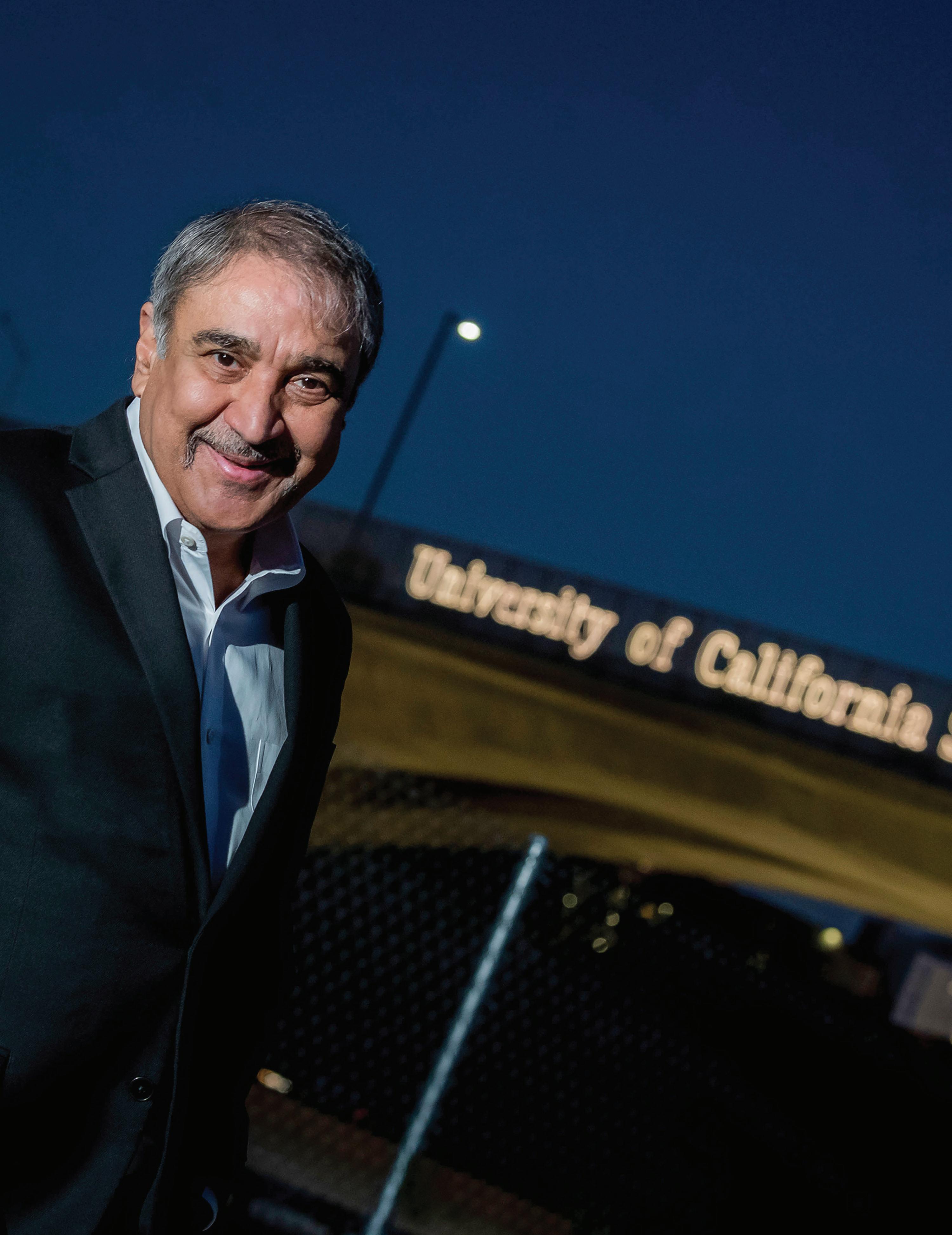
Pradeep
https://chancellor.ucsd.edu/ chancellor-khosla University
https://ucsd.edu
www.cmu.edu
hen Pradeep Khosla became chancellor of the University of California San Diego (UC San Diego) in August 2012, he believed the university was destined for greatness and spearheaded an ambitious strategic plan that made it come true.
“I saw an unpolished gem,” he says. “There’s a whole spectrum of strategies we put in place to basically position this campus as rethinking the role of public education and as a public institution in our community.”
Khosla and UC San Diego aimed high from the start, adopting a mission to “transform California and a diverse global society by educating, generating and disseminating knowledge and creative works, and engaging in public service.”

The mission succeeded. Khosla now leads a campus with more than 43,000 students (up from about 25,000 when he arrived), seven undergraduate colleges, and 12 academic, graduate and professional schools. UC San Diego is also home to the prestigious Scripps Institution of Oceanography and the UC San Diego Health Care System, a top-ranked
hospital and academic institution. With annual revenues of $6.9 billion in fiscal year 2022, the university is an academic and research powerhouse, attracting more than $1.64 billion in sponsored research in fiscal year 2022.
“What we did was think about UC San Diego as more like a holistic campus rather than multiple individual silos of excellence,” explains Khosla. “We’ve been successful at fundraising, at cleaning up inefficiencies and at rethinking the campus to be an institution for the whole community. This campus needs to be a destination for art and culture, in addition to education and health care, and doing so for the community, the whole of California, and the world.”
Now 65, Khosla is married with three children. After earning a bachelor’s degree from Indian Institute of Technology Kharagpur, he spent the majority of his career at Carnegie Mellon University in Pittsburgh, Pennsylvania, where he obtained a Master of Science in electrical engineering and a Ph.D. in electrical and computer engineering. He later joined Carnegie Mellon’s faculty as an assistant professor and rose through the ranks to become dean of the College of Engineering
and a university professor.
Although he is now an internationallyrenowned researcher and educator with research interests in robotics, artificial intelligence and cybersecurity, Khosla had to adjust to the American higher education system after arriving in the United States in 1981.
“I wasn’t used to literally studying on a daily basis,” he remembers. “In India, I was one of those ‘sprinters,’ studying before the test, studying before the final. When I came to the United States, there was daily homework and a test every two weeks. I started studying every day, and I think the end result for me was a deeper understanding of the material.”



UC San Diego has deep ties to India. As of Fall 2022, the university was home to 1,367 students from India, up almost 30 percent

Below left and bottom: Chancellor Pradeep Khosla leads a campus that is an academic and research powerhouse.

Below: The campus also houses the UC San Diego Health Care System, a top-ranked hospital and academic institution.

from a year earlier. UC San Diego also hosts 265 international scholars from India. The university has many mutually beneficial research collaborations with partners throughout India, including the Tata Institute for Genetics and Society—a collaboration between UC San Diego, Tata Trusts, and the Institute for Stem Cell Biology and Regenerative Medicine in Bengaluru. The university recently launched the 21st Century India Center, which will serve as a world-class hub for research, education and public engagement related to sustainable growth in India and advancing U.S.-India collaborations. Ambitious missions require money, and Khosla has been immensely successful at fundraising, raising more than $3 billion during his tenure and building strong ongoing relationships with donors. “Fundraising is a multi-person, multi-touch, longitudinal game,” he says. “People give to two things—great ideas and people they trust. I think that is really important, and as a leader I have to build trust with an individual so that they know that their hard-earned money is not going to be wasted, it’s going to be deployed fruitfully and effectively.”
If he could do it all over again, Khosla would repeat his move to the United States for higher education. “Despite all the ups and downs of the past few years, the United States is still the destination of choice for higher education,” he says. “There’s no other country like it. The investment the United States makes in higher education is unparalleled in the world. The United States understands how to create wealth and how to create opportunities for citizens and immigrants alike.”
Khosla is a tireless and enthusiastic advocate of closer U.S.-India relationships. “I think the stronger we can build the relationships between Indian industry and academia and U.S. industry and academia, the better it is for both countries and for the world,” he says. “So I’m here to bridge the two nations, to bridge the cultural gap, to bridge the technological gaps. I have been doing it for many years and I’ll keep on doing it. And I say to all my Indian friends, and there are a lot of them, ‘With open arms, come on over. I want to work with you. I want to be part of who you are.’ ”
Steve Fox is a freelance writer, former newspaper publisher and reporter based in Ventura, California.I think the stronger we can build the relationships between Indian industry and academia and U.S. industry and academia, the better it is for both countries and for the world.
Below: A researcher prepares a saliva sample for separation and analysis. The NSF-funded study explores how new genes evolve and how they affect saliva, which is the first interface for food entering our bodies.

The U.S. National Science Foundation (NSF) is an $8.8 billion independent federal agency created by the U.S. Congress in 1950. It supports research and education across all fields of science and technology (except for medical sciences), primarily through grants.
Sethuraman Panchanathan, current director of NSF, has spent over three decades in higher education and government. He has designed and built knowledge enterprises to advance research innovation, entrepreneurship, global development and economic growth.
Panchanathan previously served as the executive vice president of the Arizona State University Knowledge Enterprise, where he was also chief research and innovation officer. Panchanathan received his master’s degree in electrical engineering from IIT Madras in 1986 after his bachelor’s degree in electronics and communication engineering from the Indian Institute of Science in 1984. He received a doctorate in electrical and computer engineering from the University of Ottawa in 1989.
Sethuraman Panchanathan, director of the U.S. National Science Foundation, talks about the long-lasting value of research and education partnerships in science and engineering that benefit both the United States and India.
He visited India in August 2022, where he met with government officials, industry leaders, academics and students in New Delhi, Bengaluru, Vellore and Chennai.


Excerpts from an interview with SPAN magazine.
What brought you to India this August, and what was the most significant takeaway from the visit?
My visit to India was a natural extension of the conversations our nations’ leaders, including President Joe Biden and Prime Minister Narendra Modi, have been engaged in. They emphasize the long-lasting value of research and education partnerships in science and engineering that benefit citizens of both countries.
During my trip, I had the opportunity to meet and talk with many people in India who are passionate about science and engineering. Those conversations inspired me and renewed my appreciation for the incredible talent and ingenuity of the Indian scientific community.
Our past and current collaborations between researchers in the United States and India have yielded tremendous outcomes for our countries. As part of my visit, we announced more than 30 new partnerships between NSF and several Indian institutions, including the Indian Institute of Science, Indian Statistical Institute, and the Indian Institute of Technology campuses in Delhi, Mumbai, Chennai and Jodhpur. I am optimistic for the
future as I see what can be accomplished by the many researchers and students working with their counterparts and colleagues in the United States.

What are some of the key areas in science and technology where the United States and India can collaborate?
Our opportunities to collaborate and to learn from each other are in areas that the diverse citizens and communities of our two countries care deeply about and can benefit from. By working together, we can enable broader benefits of scientific research and technologies in many critical areas like environmental sustainability, agriculture, global health, national security and others.
One example of such a collaboration is our commitment to support bilateral research with the Indian Department of Science and Technology’s Technology Innovation Hubs. Those collaborations between researchers in the United States and India will leverage unique resources such as testbeds and datasets, expand work on important emerging technologies like artificial intelligence and advanced wireless communications, and encourage educational exchange.

In general, collaborative work in science and technology can help our countries better design solutions for global challenges including pandemics, and the effects of climate change.
What role do you think the U.S.-India
Below: NSF Director Sethuraman Panchanathan (left) meets Minister for Education and Skill Development and Entrepreneurship Dharmendra Pradhan during his visit to India in August 2022. Below left and bottom left: Panchanathan also met with government officials, industry leaders, academics and students in New Delhi, Bengaluru, Vellore and Chennai.Below: The NSF-supported Sustainable Healthy Cities Network connects nine research universities, major metropolitan cities in the United States and India, as well as infrastructure firms and policy groups. The network focuses on ways to reimagine energy grids, road networks, green spaces, and food and water systems to create cities that are functional, and promote the health of residents and the environment.

partnership can play in driving an exchange of ideas in science?



I see the United States and India as partners. We have shared values in the pursuit of scientific knowledge that include research integrity, transparency and reciprocity. With that strong foundation, there is tremendous opportunity for collaboration between our two nations in all areas of science, technology and engineering.
While the core mission of our scientists and engineers is to advance the frontiers of research through discovery and innovation, it is through the power of our partnerships and collaborations that those discoveries generate positive societal impact.
Rigorous scientific research requires funding, oftentimes from several sources. How might the United States support such research here in India?
India is a recognized leader in scientific research and development in South Asia, and a global leader in fields such as information and communication technology, agriculture, affordable health care, energy and water technologies. That expertise and leadership meshes well with similar areas of expertise in the United States and presents many possibilities for future collaborations.

In partnership with India’s Department of Science and Technology, NSF is supporting bilateral research at U.S. institutions and India’s Technology Innovation Hubs. We are also proud to co-invest in a wide range of
other research activities with Indian collaborators who are working to advance science, technology and education. In the past five years, NSF has made over 200 research awards involving Indian institutions and scientists, representing more than $145 million in research investments.
With NSF’s 75th anniversary coming up in two years, what is your vision for the role NSF will play in fostering partnerships to address global challenges?
NSF was founded in 1950 by the U.S. Congress to fulfill the promise of fundamental scientific research to not only increase our understanding of nature, but also to advance health, prosperity, welfare and security. And, while the world has changed a lot over the last seven decades, that mission remains just as important now as it was then.
As part of a global collaboration, built on shared democratic values, we envision science and technology as a key ingredient in fostering a more equitable and prosperous world. The sharing of ideas, resources and best practices between like-minded partners, including India, has always been at the heart of what NSF does. The grand challenges we face today do not adhere to national borders, scientific disciplines or research timelines. Take increasingly extreme weather events like brutal heat waves and droughts. Those impacts are felt throughout our communities in ways that seemed unimaginable just decades ago. This is not a problem that any single discipline
It is critical to infuse STEM learning at an early age and spark curiositydriven thinking in each and every person.
of science or any single country can solve. It will take all of us working as partners to co-create solutions that address these challenges.
Our two countries have shared a rich and fruitful history of collaboration and support for scientific research and education. As we look toward the future and the possibilities enabled by a new generation of young, talented scientists worldwide, I have no doubt that the United States and India will continue to push the frontiers of scientific discovery and innovation.
The COVID-19 pandemic impacted the global economy and every other aspect of human life. How did this affect NSF’s goals and strategies?
During the COVID-19 pandemic, the science and engineering community was challenged to tackle many unknown aspects and effects of the pandemic. We saw many opportunities for researchers to use their expertise and training to help us understand and mitigate the disease itself and to broadly help our society cope with the vast economic and societal aspects of the pandemic.
I am proud to say that NSF and the research community rose to that challenge, and we invested in more than 1,200 rapid response research projects in a very short period of time. Those NSF-fueled research projects discovered important things about the nature of the pandemic, such as how the virus spreads and how to best detect it, its impact on the economy and supply chains, the effects on childhood education and many other vital areas. This demonstrates NSF’s agility to respond to emerging challenges faced by society. I see this as an affirmation of NSF’s core values and our goals as an organization to support the scientific enterprise and create lasting value for people.
Climate change is a serious challenge, especially in India. In what ways can innovation and technology help us?
I strongly believe that scientific innovation and cooperation can show us the path to any outcome we want to realize, and that includes creating a prosperous and healthy future for everyone. For example, India has set ambitious goals for renewable energy production and strengthening climate resilience. Scientific and technological innovation will be a powerful tool in achieving those goals.
Collaborations between NSF and India will advance our shared ability to ensure resilience
in areas such as human health, climate, agriculture and transportation. For example, NSF supports collaborative research in the physical sciences, engineering and the social sciences, which aim to address challenges in climate mitigation, adaptation and resilience. Those collaborative projects include work on solar technologies, offshore wind, reducing methane emissions, carbon capture, power grid stabilization and much more.
Scaling up such collaborative efforts can amplify their long-term value and impact. We must also work together to make the process of collaboration and shared innovation as efficient as possible so that our countries, and the world, can reap the benefits.
At IIT Delhi, you spoke about creating new pathways so that talent from every demographic and community can join the STEM community. What is one key factor that will encourage more young people to make long-term contributions in STEM fields?

One of the most powerful ways we can get students interested in pursuing STEM careers is by fostering the innovative mindset that resides in all of us. It is critical to infuse STEM learning at an early age and spark curiosity-driven thinking in each and every person. We are all explorers from the moment we are born. I see that every day through my granddaughter. She is curious about everything and is so excited to explore and understand the world around her.
This is an innate curiosity we are all born with. It is what made me want to get into science. When I was 8 years old, my father took me to the U.S. Consulate in my
hometown of Chennai to see Moon rocks brought back by the Apollo 11 astronauts. I was absolutely transfixed by the idea that humans could design and execute a mission to the Moon, get these rocks, and bring them back for young children in India who would be inspired by them. That early experience is what sparked my interest in science—and it is something that everyone can experience. Curiosity is something we must cultivate and nurture in young people. We must empower youngsters with a can-do spirit and help them recognize that they can indeed do anything.
You have often talked about the need to make STEM education inclusive and accessible to all. Why is that important to you?
To remain at the vanguard of discovery and innovation, it is imperative that global science leaders like the United States and India leverage every bit of talent to engage in fundamental discoveries, design novel approaches and build transformative technologies. I believe the key to doing that is by harnessing the ingenuity that exists in communities of every size and type, from big cities to rural towns.
Before I came to NSF, I was at Arizona State University where we chose to expand access to higher education for students from a broad range of socioeconomic backgrounds with diverse experiences. This helped enrich our classrooms and laboratories in ways that you simply cannot put a price on.
You have years of experience in research and academia in the United States. What would be your advice for Indian students who want to pursue higher studies or research in the United States?
For students in India and around the world, as you go forward on your own journey, I ask you to keep an open mind and always engage your curiosity to know more about the world around you. You must experiment and you must experience. You must continue to stay involved, take risks, make connections and find mentors.
I am deeply grateful for the education and opportunities that both India and the United States have provided me, and I feel compelled to make it a priority that this same access to opportunity is available to absolutely anyone who has the determination to harness their innovative spirit.
Assistant Secretary of Commerce for Global Markets and Director General of the U.S. and Foreign Commercial Service Arun Venkataraman visited India in January 2023. During his visit, he met with government officials in New Delhi to promote U.S.-India trade ahead of the U.S.-India CEO Forum in March 2023. In his meeting with Joint Secretary Dinesh Dayanand Jagdale of the Ministry of New and Renewable Energy, Venkataraman sought to identify opportunities for U.S. cleantech companies to assist India in achieving its energy sustainability goals. He also met with his counterparts at the Department of Telecommunication, Ministry of Defence, Ministry of Electronics and Information Technology, and Ministry of Commerce and Industry to explore opportunities for deeper commercial cooperation and engagement. In Mumbai, Venkataraman met with some of India’s top business leaders to work toward a productive U.S.-India CEO Forum meeting in March.


Born in Coimbatore, Tamil Nadu, and raised in Houston, Texas, Venkataraman holds a juris doctorate from Columbia Law School, a Master of Arts in Law and Diplomacy from the Fletcher School of Law and Diplomacy, and a Bachelor of Arts from Tufts University.


 By KRITTIKA SHARMA
By KRITTIKA SHARMA
The United States-India Educational Foundation (USIEF) organized the Annual Fulbright Conference in November 2022, the first such gathering of FulbrightNehru awardees in India after the COVID-19 pandemic. The conference hosted 110 American Fulbrighters over three days in New Delhi, during which they presented their research and networked with other academics.
The Fulbright Commission was signed into existence in 1950 by Prime Minister Jawaharlal Nehru and U.S. Ambassador Loy Henderson. Fifty eight years later, in 2008, India became a full partner in the programmatic funding of the exchange program, now known as the Fulbright-Nehru program.
The U.S. Fellowship awards grants to U.S. college seniors, graduates and academics at all levels to conduct research at a host institution in India and carry out professional projects mentored by Indian academic supervisors. During their tenure, the Fulbrighters apply their expert knowledge of a field to the Indian context, study real-time issues and learn from their counterparts in respective fields. For many, this tenure brings invaluable exposure as they work with closely-knit communities, allowing them to form crucial relationships.

Do you self-medicate with antibiotics for common colds or mild fevers? Have your antibiotics stopped being effective? Research has found that India has one of the highest rates of antimicrobial resistance (AMR) in the world. This means more and more people will not respond to antibiotics when they fall sick. At the same time, no new antimicrobials are being developed to treat drug-resistant infections.
For Fulbright-Nehru Student Researcher Mariam Alkattan, this was an opportunity to study AMR in India and spend the next nine months setting

up a research lab from scratch. Alkattan has a Master of Science in environmental engineering from the University of Massachusetts, Amherst. She was hosted by the National Forensic Sciences University in Gandhinagar, where she started her Fulbright-Nehru tenure in April 2022.
A large part of Alkattan’s research involved sampling water bodies over several months in and around Ahmedabad to check for biological contamination and drug resistance. The team found that out of the almost 100 water samples they collected,
Above: Fulbright-Nehru Research Scholar Laura Gascogne exchanges ideas with Asit Das, a stone sculptor, during a terracotta workshop at Bankura University’s Jamini Roy Institute of Art & Culture (Abhibyakti) in West Bengal.
Below: A large part of Mariam Alkattan’s research involved sampling water bodies over several months in and around Ahmedabad to check for biological contamination and drug resistance.

every sample contained resistance to at least one of the drugs they were tested against. In addition, many of the samples were resistant to multiple drugs, a significant finding that implies the presence of infections that are more difficult to treat.
Contamination of water bodies by human and animal waste, crop pesticides and pharmaceutical waste has wide ramifications for those who use these water bodies as sources for drinking, cooking or washing, and leads to AMR mutation and creates antibiotic resistance.
Even though the study of AMR has a long way to go in India, according to Alkattan, her research aims at creating standardized testing for AMR. “We don’t even have a standard method [to measure AMR]. With our research, hopefully, we’ll be able to provide information on accuracy and ease of use of tests.”

Alkattan spent the first few months of her fellowship learning things she had never been taught before. “I had to learn from reading the available literature, and create a research program from scratch,” she says. “This was incredibly difficult, but something I could only do with Fulbright; it gave me the time and freedom to do that.” Alkattan hopes to establish some groundwork on AMR before she leaves India. “I hope the payoff of doing something so complicated is that we have a foundation of data and methods for scholars to continue AMR research,” she says. Alkattan leaves behind the lab, which was not there when she arrived. She has also created some fun memories in the process. “While collecting samples in Ahmedabad, one site was really close to an ice cream shop. So, we used to go to ‘sample’ the ice cream,” she giggles.
Going forward, Alkattan hopes, through her work, to “share information on best practices and inform policy regarding environmental AMR.”

Lydia Fisher was 21 and a junior at Bryn Mawr College when she came to India—and New Delhi—as a member of her study abroad program SIT: India (School for International Training). Having grown up in Unionville, Pennsylvania—a small town outside Philadelphia with a population of about 600 people—Delhi’s air and noise pollution came as a shock to her, she says. But she wanted to know more about the people and their environment and it brought her back to India three years later, this time as a FulbrightNehru Student Researcher.
At Bryn Mawr, Fisher majored in international studies with a focus on environmental and public health issues. She has been in India since March 2022, researching the effects of air and noise pollution on the human body and society. She is affiliated with Tata Institute of Social Sciences (TISS) in Mumbai and advised by Dr. Amita Bhide. Her air pollution work is focused on the residents of the M-East Ward—a municipal area in Mumbai and home to one million people. The area is also home to a range of major air pollution sources, including one of Asia’s largest garbage dumping grounds and the largest biomedical waste facility.
Fisher says her work revolves around studying air quality, monitoring and governance, and looking through regulations. Her research, says Fisher, will inform policy on air pollution education and the treatment of air pollution-induced health issues. “The human body breathes 11,000 liters of air every day. Our research is to find out what exactly is in the air that people are breathing,” she says.
Research has found that perception of air pollution has a major impact on decisions on exposure, and is usually studied in social and economic contexts. For example, a person who usually stays in an air-conditioned environment might find a five-minute exposure to outdoor pollution more uncomfortable than a roadside vendor, even though the effects of the pollution on the body are

the same in both cases.
The second component of her research—noise pollution—focuses on the effect of elevated street noise on residents and traffic police in Mumbai. Mumbai is one of the loudest cities in the world and Fisher says ambient street noise averages around 70 to 80 decibels. Traffic cops bear the brunt of this noise with horn blasts and vehicles coming at them from every direction. Fisher says her work investigates the health consequences of exposure to elevated traffic noise in their daily work, contextualized by their understanding of the issue and their access to treatment.
Fisher says long-term exposure to high noise levels leads to hearing loss and stress as well as an increased risk of hypertension and diabetes. “There is a lot of research on this, but most of it comes from Europe and the United States,” says Fisher. But, she explains, noise and its effects on people have to be studied in social and cultural contexts. For example, she says, hearing loss is related to genetics, environment and exposure. “And India has a very high rate of hearing loss,” she explains.
Currently, Fisher is working on a survey of 400 residents of the six settlements in the north of M-East Ward. The survey investigates indoor and outdoor air pollution health effects, and treatment choices at the local level.

Mumbai-based Vani Dewan is a Fulbright-Nehru Student Researcher, studying the neurological connections between earlylife stress and its effect on mental and physical health across a lifetime. When not in the lab, she spends her time DJing in Mumbai clubs, teaching choir to students at the Muktangan school, which involves lessons in breathing, posture, enunciation, tone, emotion, storytelling and more.
Dewan graduated from Scripps College in California in 2021, with a degree in neuroscience. She is hosted by the Tata Institute of Fundamental Research, where she works at neuroscientist Vidita Vaidya’s Neurobiology of Emotion lab.


The lab is involved in rodent research to find how early-life stress can create physiological changes in rodents, and the potential effects of pharmaceutical and psychedelic therapies in such cases. “Understanding this connection between psychological and physiological phenomena has blown my mind,” she says. Rodent research is beginning-of-


the-pipeline work, findings of which get extrapolated on humans following years of subsequent research, explains Dewan.

Dewan is grateful for the experience and independence the Fulbright-Nehru program has brought to her. “Being financially independent in the first year after graduation is a very big deal for me,” she says. “I’ve been able to completely self-sustain this entire year.”
She says the Fulbright-Nehru program has put her in the space of mental health and neuroscience research that she wouldn’t have been able to access on her own. On the personal front, she got a chance to dabble in DJing. “DJing here has been a joy. All my favorite musical genres are well represented here in Mumbai,” she says.
Though her tenure in India has been of just nine months, Dewan takes back with her invaluable experience and memories. Most importantly, as an Indian American, Dewan says the time in Mumbai has added more depth to her identity. “I realized how American I am after spending time in India,” she smiles, but adds, “I will return to the United States more Indian than I ever was before.”
Top: Vani Dewan’s research involves finding neurological connections between early-life stress and its effect on mental and physical health across a lifetime.
Left: When not in the lab, Dewan spends her time teaching choir to students at a school in Mumbai.

I realized how American I am after spending time in India. I will return to the United States more Indian than I ever was before.
Sandhya Gupta, a consular officer at U.S. Embassy New Delhi, was in India in 1998-99 to study women’s foray into local government politics. Her research focused on women in rural Haryana and it left an indelible mark on her, she says, even while she studied law and became an attorney. She returned to India in 2020 as a U.S. diplomat.
Excerpts from an interview.
Please tell us about yourself and your role in the U.S. Embassy in India.
Before I joined the U.S. State Department in January 2020 as a Foreign Service Officer, I was a civil rights attorney in Cleveland, Ohio, where I was born and brought up. I had moved back to Cleveland after studying and working in New York City. Before that, I also spent some time in Washington, D.C., working for an international human rights organization.
As a civil rights attorney, I represented plaintiffs who were suing companies, public agencies, or others who had allegedly violated their rights. It was very intensive work, not only deepening my commitment to equity and justice but also building my skills in, for example, analytical writing, research, case management, and oral communication— skills I believe are also applicable in the Foreign Service. While there were various reasons for shifting to the Foreign Service after a career in law, I credit my Fulbright experience for planting the diplomacy seed.
I now work as a consular officer in New Delhi, where I adjudicate nonimmigrant visas. I also spent about a year during this first tour working as a staff assistant in the Embassy’s Executive Office, where I supported the Chargé d’Affaires and the Acting Deputy Chief of Mission.
Can you tell us more about your time in India as a U.S. Fulbright scholar?

I was a Fulbright scholar in India from 1998 to 1999. It’s hard to believe I came here nearly 25 years ago. My research was focused on women’s participation in panchayati raj (rural village councils). A few years earlier, India had passed a constitutional amendment mandating that one-third of all local government seats be filled by women. It was an opportune time to see how that policy had been implemented in rural areas.
My research initially was focused on the Haryana region because of a connection I made with a professor at Kurukshetra University and because it was close to Delhi, where I was based. There I visited villages and met with women serving on panchayats. But my research also took me around the country and I was able to compare the experiences of different regions.
The Fulbright afforded an extraordinary opportunity to meet people, gain insights into social factors affecting women’s pursuit of their ambitions, and visit places, especially villages, where I would otherwise never have gone. I will never forget singing the American song “We Shall Overcome” with school girls in Andhra Pradesh or sleeping on the rooftop of a family’s home in a village. I am grateful to the Fulbright program for the opportunity to explore, see the diversity of India, and build deep and lasting friendships.
Why did you choose India for your Fulbright research?
Before coming to India, I had studied abroad in South Africa in 1997. It was an amazing time to be there because South Africa had recently held its first democratic elections and was grappling with its past of human rights abuses. I attended several hearings of the Truth and Reconciliation Commission and traveled to rural areas to study local governance structures in post-apartheid
U.S. diplomat
Sandhya Gupta talks about her return to India more than 20 years after her Fulbright fellowship in the country.Photographs courtesy Sandhya Gupta
South Africa. I was interested in how democracy is strengthened when people take an active part in local decisionmaking. From South Africa, it was a natural connection to come to India, given similar threads in the two countries’ democratic movements. The early anti-apartheid movement was influenced by India’s own independence struggle, for example; and of course, Mahatma Gandhi’s philosophy of nonviolent resistance took root during his time in South Africa.
How did your Fulbright experience in India influence you as an attorney in the United States?
My interest in going to law school was always to promote social justice, advocate for those who might be marginalized in society, and support them in their fight for their rights. This focus was closely aligned to my Fulbright research on empowering women to participate in public decision-making. I was inspired during my Fulbright year talking to villagers about the power in their own hands to make change—India has a rich history of this and I remember connecting to people through references to giants such as Mahatma Gandhi and his vision for village-level self-government. I saw the same inspiration in clients I later represented who spoke truth to power or exercised their right to vote. In both cases, a combination of top-down law and policy and bottom-up empowerment efforts drove change.
What were your thoughts when you got to know that your first tour with the U.S. Department of State will be in India?
I was thrilled, although it wasn’t a total surprise because I had placed India very high in my list of preferences. I thought it would be very meaningful to come back and start my Foreign Service career here. Back in 1998-99, I heard it
said that Fulbrighters straight out of college, as I was, would be the future diplomats of the bunch. I didn’t give it much thought until many years later, when I was considering the Foreign Service, and then it felt like things were coming full circle. I was conscious even during the Fulbright of how people-to-people connections built through the program can deepen mutual understanding between the two countries. So to come back in an official role to further that relationship was very meaningful.
What is the most exciting thing about working as a U.S. diplomat in India?
Serving as a U.S. diplomat in India has been an absolute privilege. I’ve had access to places and experiences that have afforded me unique insight into culture as well as the bilateral relationship. But when I think about my time in India, without a doubt the greatest privilege has been connecting to and learning from incredible people— whether those I interact with on a daily basis or those I have met in an official capacity.
I think, for example, of the Tibetan government-in-exile official who greeted me warmly and described herself as Bharat ki beti (a daughter of India). Or the social entrepreneur working on transforming municipal solid waste into energy. Or the interns at a disability-rights organization who showed me what it means to look out for one another. Or my local staff colleagues at the Embassy who have repeatedly answered the call to promote diversity, equity, inclusion and accessibility—and have brought so much heart and talent to the effort. The moments where I have felt the most connected, delighted, or moved have been those moments of connection with people. That has made this tour truly extraordinary.
www.usief.org.in/FulbrightNehru-Fellowships.aspx
https://in.usembassy.gov
Top: Sandhya Gupta came to India in 1998-99 as a U.S. Fulbright scholar to study women’s participation in panchayati raj. Her research was focused on women in rural Haryana.

Above: Gupta (third from left) with members of a panchayat at a conference.


(November 2022)






(October 2022)
(September 2022)


The United States and India are Major Defense Partners. The U.S.-India defense partnership is a foundational pillar of a free and open Indo-Pacific, bolstered further by shared values and strategic interests.
The United States conducts more joint military exercises with India than with any other country. Yudh Abhyas and Tiger Triumph are two examples of exercises that reinforce the U.S.-India defense partnership. The navies of the United States and India are instrumental in deepening multilateral cooperation in the Indian Ocean, including through joint exercises and exchanges with other partners in the region.

The growth in our bilateral defense trade has corresponded with growing interoperability between U.S. and Indian services through information sharing, liaison officers, increasingly complex exercises, and defense enabling agreements, such as the COMCASA (Communications Compatibility and Security Agreement).

The U.S.-India military relationship is an enduring partnership that strengthens with each successive bilateral opportunity.
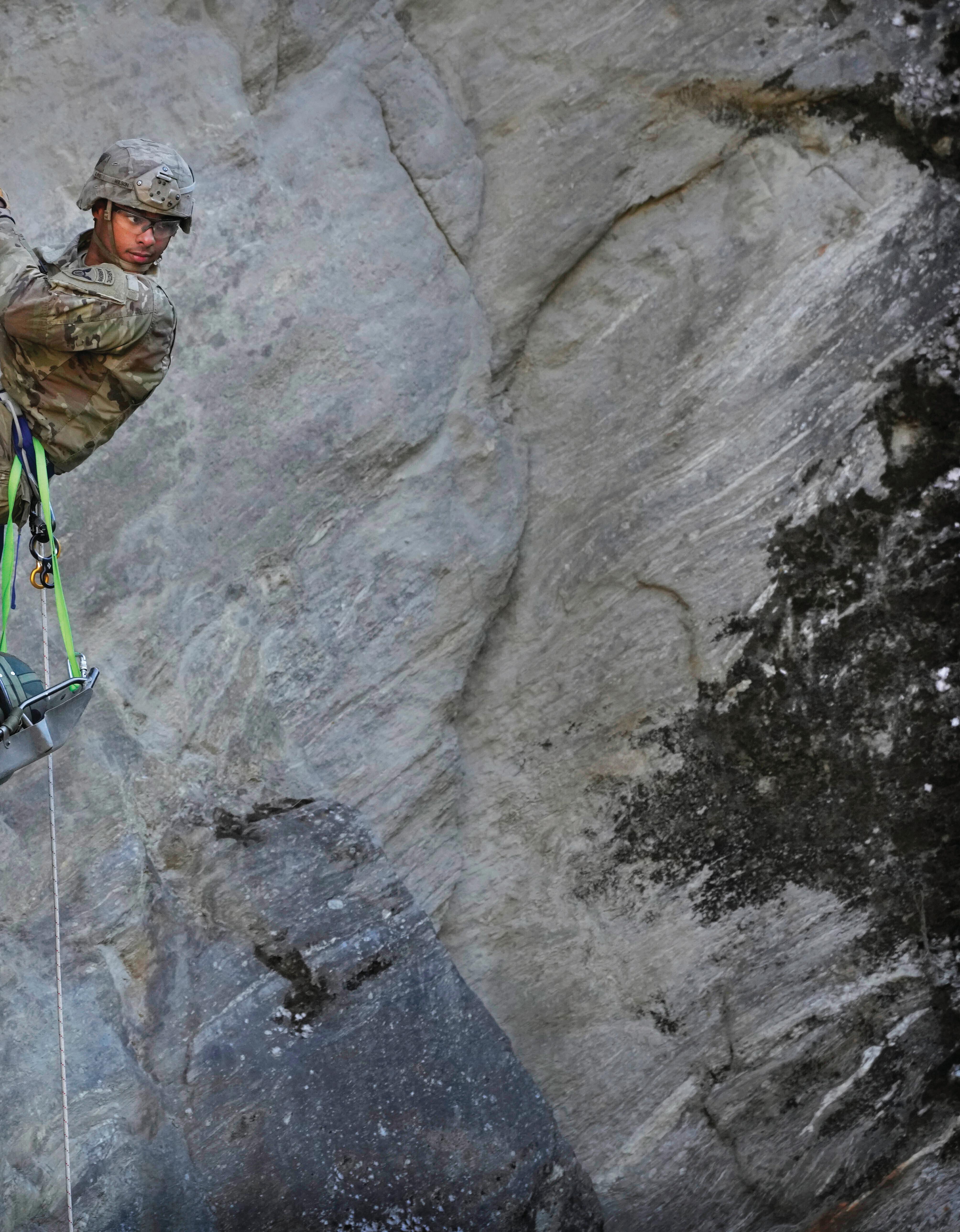 Left: U.S. and Indian Army soldiers carry out a mock rescue operation as part of humanitarian assistance and disaster relief operations during the Yudh Abhyas joint exercise in Uttarakhand.
Above right: Indian American Air Force Colonel Biren Oberoi (right) in Visakhapatnam for the second edition of the Tiger Triumph, a bilateral tri-services exercise between the U.S. and Indian militaries.
Above far right: U.S. Coast Guard Cutter Midget (WMSL 757), the largest and most technologically advanced of the Coast Guard’s newest classes of cutter, arrives at Chennai Port Trust for a bilateral exercise with the Indian Coast Guard just off the coast of Chennai.
Left: U.S. and Indian Army soldiers carry out a mock rescue operation as part of humanitarian assistance and disaster relief operations during the Yudh Abhyas joint exercise in Uttarakhand.
Above right: Indian American Air Force Colonel Biren Oberoi (right) in Visakhapatnam for the second edition of the Tiger Triumph, a bilateral tri-services exercise between the U.S. and Indian militaries.
Above far right: U.S. Coast Guard Cutter Midget (WMSL 757), the largest and most technologically advanced of the Coast Guard’s newest classes of cutter, arrives at Chennai Port Trust for a bilateral exercise with the Indian Coast Guard just off the coast of Chennai.
Above: U.S. and Indian Army soldiers participate in humanitarian assistance and disaster relief drills during the Yudh Abhyas joint exercise in Uttarakhand. (November 2022)

Left: Sailors from the USS Frank Cable (AS 40) plant trees during a visit to Andhra University. (August 2022)

Below: Students from St. Joseph’s College for Women on a tour of the USS Frank Cable (AS 40) in Visakhapatnam, where they spoke with female leaders onboard the ship about women’s empowerment and leadership. (August 2022)

Above: Sailors salute India’s Deputy Chief of Naval Staff, Vice Admiral Sanjay Mahindru, on the flight deck of the aircraft carrier USS Abraham Lincoln (CVN 72) during Rim of the Pacific (RIMPAC). RIMPAC is the world’s largest international maritime exercise, with 26 nations, 38 ships, four submarines, more than 170 aircraft and 25,000 personnel participating. (July 2022)

172
Below: The U.S. Navy’s only forward-deployed aircraft carrier, USS Ronald Reagan (CVN-76), steams in formation with Indian Navy Ship INS Shivalik (F 47) in the Philippine Sea for the 26th
Malabar exercise. The series of exercises began in 1992 between the United States and India. The exercise has evolved in scope and now includes Japan and Australia. (November 2022)

2022. CTF 172 is the Maritime Patrol and Reconnaissance element of RIMPAC comprising service members from the United States, Australia, Canada, India, Japan and the Republic of South Korea. (July 2022)

Right center: Mike Hankey, U.S. Consul General in Mumbai (center), at the India DefExpo in Gandhinagar. (October 2022)

Right: A roundtable of representatives from the U.S. government and defense industry at India DefExpo 2022.

United States Secretary of the Navy Carlos Del Toro set up a program management and engineering firm SBG Technology Solutions in 2004 with his wife out of their home in Virginia. Seventeen years later, SBG Technology Solutions is a company of 120 employees, making about $40 million in revenue.
During his visit to India in November 2022, Del Toro brought his experience as not just a defense expert and an official of the U.S. government, but also as a seasoned entrepreneur. During an interactive session with students and entrepreneurs at the American Center New Delhi, he explained that one of the keys to starting any business is a “desirable requirement” in the commercial market for the product, so that it can be sold and scaled. “For many companies, especially start-ups, it is important to have a broad market and to have different strategies to sell your products,” he said while responding to a question on a fire safety product developed by an alumnus of the U.S. Embassy’s Nexus Start-Up Hub. Del Toro also said that it is equally important to sell a product in the government or defense market, apart from commercial. “Of course, doing work with
the government and the defense marketplace comes with, sometimes, a different set of regulations that you have to comprehend, embrace and understand…But I think the success of your company increases significantly with having as broad a market as possible that you can sell to. So, creating that product with both markets in mind makes a lot of sense,” he said.
In addition, Del Toro said that the United States is considering opening a branch of the Office of Naval Research in India, where entrepreneurs will be given the platform to expand their market access in both countries.

U.S. Secretary of the Navy Carlos Del Toro speaks on the intersection of start-ups, climate action and defense during his interaction with students and entrepreneurs.
“I do hope that in future years we might be able to come to an agreement to be able to establish a global office here that entrepreneurs can bring ideas to. We could then try to help you expand your marketplace, both here and in the United States as well,” he said.
While answering a question posed by a Nexus alumnus, Del Toro said that the United States and its Navy are taking significant steps to tackle waste and climate change at different levels. “We take this responsibility very seriously in the Department of the Navy. The time I served in the Navy, we threw garbage and plastics overboard. We don’t do that anymore unless it’s completely biodegradable,” he explained.
Other than that, he said, the Department of the Navy and the Marine Corps have invested in solar and wind energy efficiencies at the Marine Corps base in Albany, Georgia. The Department of Defense has also made major investments in electric cars, he added.


Secretary Del Toro also answered several questions on the safe exchange of intelligence, on cyber security and defense cooperation, posed by students of international studies.
 By KRITTIKA SHARMA
By KRITTIKA SHARMA
Highlighting the importance of war exercises and international cooperation, the Secretary of the Navy said it is extremely important to learn to operate with each other on a regular basis. “The more we learn to operate with each other, the more we’ll be able to trust and understand how each of our Navies and Marine Corps, and other services, work together. This way, if we ever have to deter an adversary collectively, we’ll know exactly how to operate together,” he said. “In the United States, there’s a phrase that we use that says, ‘we like to train the way that we fight.’ And it’s important to do that on a regular basis.”

s a practicing emergency physician and global health policy specialist, Dr. Amit Chandra works on health concerns related to air pollution and digital innovation. His practice settings have been varied and range from a referral hospital in Botswana and a busy trauma center in New Delhi to a New York City emergency department and a frontier hospital on a Native American reservation.
Dr. Chandra is currently a senior emerging health challenges adviser with the U.S. Agency for International Development (USAID) Bureau for Asia in Washington, D.C., where he supports USAID’s health team in India.

Since joining USAID in 2019, he has

traveled extensively in India to rural health and wellness centers supported by the agency in Madhya Pradesh and Tripura. The health and wellness centers are designed to bring health services closer to local communities.
Dr. Chandra’s connection with USAID goes back a long way—his father, Subash Chandra, too worked with the agency. “It is a great honor to work closely with USAID/India colleagues and to walk into the same buildings where my father worked in the 1960’s,” he says. “When I work with Indians supporting USAID development partnerships, it makes me feel connected to my father.”
Dr. Chandra’s father began his career with USAID in 1962 as an accountant at the Technical Cooperation Mission at U.S. Embassy New Delhi, which later became the USAID Mission when the agency was launched in India. His work with USAID took him to Kabul, Afghanistan, where he was the chief of the dollar section in the accounting department.
“My work with USAID at the beginning of my career exposed me to international affairs, diplomacy
 Above: Subash Chandra (right) joined the Technical Cooperation Mission, which later became USAID, at the U.S. Embassy in New Delhi in 1962.
Right: Dr. Amit Chandra (far right) followed in his father’s footsteps and joined USAID in Washington, D.C., in 2019.
Above: Subash Chandra (right) joined the Technical Cooperation Mission, which later became USAID, at the U.S. Embassy in New Delhi in 1962.
Right: Dr. Amit Chandra (far right) followed in his father’s footsteps and joined USAID in Washington, D.C., in 2019.
A father-son duo maps how USAID’s work has evolved and helped strengthen the U.S.-India partnership.
and international development,” Mr. Chandra says. “After USAID, I devoted the remainder of my career to these issues around the world as a diplomat and finance specialist with the World Bank.” Mr. Chandra joined the World Bank in Washington, D.C., in 1972 and retired in 1999 as a senior disbursement officer.
The father and son’s careers at different times at USAID reflect the agency’s growth and development globally, and in India. Since the 1960’s, USAID has worked with the Government of India and other development partners on a range of issues.
As Mr. Chandra says, “In the 1960’s, USAID provided essential development assistance to India. For example, through wheat donations under the PL-480 program. USAID also provided other grants, and financial and technical assistance to support India and address a variety of other development challenges like health, food security, agriculture and infrastructure.”
Today, as Dr. Chandra’s work with the rural health and wellness centers shows, the relationship has moved toward partnership-based programs.
USAID collaborates with partners across India to address issues related to clean energy, environment, the climate crisis, health, open and inclusive digital ecosystems and inclusive economic growth.

For instance, “The Indian government has identified air pollution as a major challenge and USAID is partnering with it in the clean energy and health space,” says Dr. Chandra.
“Unlike many other public health challenges, air pollution is not just a health sector concern. It’s also related to economic growth, manufacturing, transportation and public education where people need to have
the knowledge of how to adopt everyday practices that do not contribute to air pollution.” This takes enormous coordination across different units. In a bid to ensure better health outcomes, the Indian government is working toward strengthening its Comprehensive Primary Health Care programs across the country through the Ayushman Bharat program and with technical assistance provided by USAID.
Dr. Chandra’s work at the health and wellness centers provides many opportunities to meet dedicated public health medical officers stationed in rural areas. “It is inspiring to learn about how USAID’s partners are improving the delivery of health services,” he says. “Meeting community members who have stepped up to become local leaders and local agents of health care, like the accredited social health activist (ASHA) workers, shows how important it is to create links between these health centers and the individuals they serve through trusted local people.”
Dr. Chandra attributes his intersectional and international health policy approach to the exposure to his father’s international work and to his frequent travel to India while growing up. “Our family’s biannual visits to India gave me a chance to see how the country was changing,” he says.
His advice to those interested in similar work is simple. “Take any opportunities to work in the field,” he says. “Get hands-on experience addressing technical challenges outside of headquarters buildings or offices. My work treating patients in hospitals in New York City and in Botswana, and my experiences visiting rural clinics in India inform the work I do every day.”

inki Chatterji covers the Global Health and Cognitive Epidemiology portfolio that includes population aging research initiatives and Harmonized Cognitive Assessment Protocol (HCAP) projects at the National Institute on Aging (NIA), one of the institutes within the U.S. National Institutes of Health (NIH). She provides administrative and technical oversight for the Longitudinal Aging Study in India-Diagnostic Assessment of Dementia (LASI-DAD) project, which maps the study of late-life cognition and dementia.
Funded by NIA, LASI-DAD involves multiple U.S. and Indian partners including the University of Southern California, Harvard University, University of California at Los Angeles, University of California at San Francisco, University of Michigan, Johns Hopkins University, University of Pittsburgh, the University of Minnesota, the All India Institute of Medical Sciences, International Institute for Population Sciences and Venu Institute.
Excerpts from an interview.
You were recently in India for the Longitudinal Aging Study in IndiaDiagnostic Assessment of Dementia (LASI-DAD) wave 2 study. Could you tell us about this important initiative, and why it matters to the United States and India?
India, one of the most populous countries in the world, will soon
Minki Chatterji covers the Global Health and Cognitive Epidemiology portfolio at the National Institute on Aging, one of the institutes within the U.S. National Institutes of Health.
 By GIRIRAJ AGARWAL
By GIRIRAJ AGARWAL
experience rapid aging. By 2050, India’s population aged 60 years and older is projected to reach 320 million, about the current size of the entire U.S. population.
LASI-DAD enables researchers to study late-life cognition and dementia, and its risk factors, in this growing population.
Although a rising burden of dementia presents an urgent challenge, previous efforts to study this condition have relied on samples in geographically limited regions. The LASIDAD is significant not only in providing a new scientific foundation for dementia research in India using nationally representative data, but also in its rich data on risk factors, including genetics and exposure to air pollution.
The LASI-DAD sample is drawn from the larger Longitudinal Aging Study of India (LASI), a survey of the health, economic and social well-being of people aged 45 and older. Its large sample of over 72,000 represents the national population with sufficient sample sizes across the country.
LASI-DAD recruited a sub-sample of over 4,000 LASI respondents aged 60 or older from 19 states and union territories across India, administered the HCAP cognitive tests, and interviewed a family member or friend identified through participants.
These projects provide accurate information about dementia to government agencies and non-governmental organizations that help inform policy development and program implementation for aging populations in India.
The projects are also important for NIH and NIA because the data provides researchers the opportunity to conduct comparative analyses. It is hoped that this research will help identify
An NIH-funded study is helping understand dementia and inform policy development for aging populations in India.
int You were Agin Assess wa tell us about this an a d matt States and In countries in Left: Mink Health portfoli
risk and protective factors for Alzheimer’s disease and related dementias, which will help improve the lives of the aging population worldwide.

What do you think are some of the areas the United States and India can deepen collaboration in health research, and why?


The U.S.-India collaboration on the LASI and LASI-DAD projects are a great example for us moving forward. NIA has been focused on developing comparable data for aging and dementia research across countries, including the U.S. Health and Retirement Study. The development of the HCAP was intended to make it possible to have internationally comparable data for population-based dementia research. The LASI and LASI-DAD studies are a step in this direction.
Another example of collaboration in the context of LASI and LASI-DAD was the ability to move rapidly to collect real-time data about COVID-19 during the height of the pandemic.
In addition, given projections that climate change will worsen the effects of infectious diseases in the future, there will be opportunities to use these internationally comparable studies to examine these effects.
Could you tell us a little bit about your experiences working on this study in India? Do you have any

favorite places you visited? Any favorite foods, films, or experiences you’d like to share with our readers?
It was great to be back in India after the pandemic. After wrapping up my official activities in Delhi, I took my parents to Kolkata for a visit filled with a lot of nostalgia whilst visiting Prinsep Ghat, Victoria Memorial and Gariahat Market. I’m also a big foodie, so coming to India is always a big treat!
You are a public health expert and a working parent. Would you like to share any message to young people in India, particularly to young women on higher education or a career in the sciences?



I am a global health expert and proud


mother of three daughters, ages 25, 22 and 16. While it was challenging to balance my global health career and parenting, I was blessed to have the strong support of my wonderful husband who did so much to enable my career to blossom. I also think that my career has inspired my daughters to pursue their professional dreams as well.
My message to the young people in India, particularly young women, is to aim high while striving for work-life balance. I look forward to seeing the achievements of the next generation of women and men. In terms of health inequality, I see great progress and I look forward to even more through our partnership.
Photographs courtesy Minki Chatterji

 By NATASA MILAS
By NATASA MILAS

adhulika Guhathakurta is a program scientist at NASA (National Aeronautics and Space Administration) headquarters and senior adviser for new initiatives at NASA’s Goddard Space Flight Center in the Heliophysics division. For the past two decades, Guhathakurta has led the development of Heliophysics as an integrated scientific discipline.
Guhathakurta was the lead program scientist with the Living With a Star (LWS) program at NASA for 16 years, which studies the changes in the levels of solar radiation and its effects on Earth. As the LWS program lead, Guhathakurta oversaw development of flagship missions like the Solar Dynamics Observatory, which gave us a closer look at the Sun, the Solar Terrestrial Relations Observatory (STEREO) that gave us the first 3D image of the Sun, and most recently the Solar Orbiter mission—an international cooperative mission between the European Space Agency and NASA—all of which are revolutionizing our understanding of how the Sun shapes space weather in the solar system.
Guhathakurta holds a master’s degree in astrophysics from University of Delhi and a Ph.D. in solar physics from the University of Denver, Colorado.
Excerpts from an interview.
Can you tell us about your educational and professional journey to NASA?
It has been quite a journey! As a young girl growing up in India, I watched humans step foot on the Moon. In those days America, NASA and even science itself were mere concepts—vague and unformed in my young mind. Yet, as I talk to you, I find myself an integral part of that very organization. And, through the science we pursue
here every day, I have reached out into space and touched the Sun itself.
What once appeared vast and unconquerable to a young Indian schoolgirl is now the routine of my daily life. And I have the privilege to do so in the company of my brilliant colleagues—people of every stripe and persuasion.

Why did you choose to study astrophysics?

Very early on, perhaps, after my grandmother passed away and I was told she turned into a star in the sky, I got hooked on watching the night sky. I was then constantly asking my father: “Where do we come from?” and “what happens to us when we die?” My father tried his best not to shut me up—instead he reasoned with a 6-year-old. He drew a circle and said, “Well, can you tell me where the beginning or the end of this circle is?” That just stuck with me.
Solving puzzles, playing games, reading about dinosaurs, visiting the planetariums, staring at the night sky—the world around me inspired me to be a scientist. As a grown-up girl, I also loved cosmology—I loved connecting science to philosophy and spirituality.
For the past two decades, I have enabled the development of Heliophysics as an integrated scientific discipline, from which fundamental discoveries about our universe provide direct benefits to society. As the lead for the Living With a Star program, I helped make possible several flagship missions like the Van Allen Probes that give us a view of hazardous energy particles trapped in Earth’s radiation belts and a mission to “touch” the Sun through the Parker Solar Probe.
To accelerate innovation and scientific discovery,
Madhulika Guhathakurta talks about her study of the Sun, its effects on
and how the Sun shapes space weather.
I helped create funding mechanisms to shepherd traditional domain scientists out of their comfort zones. We now have LWS system science known as the Targeted Research and Technology program and Focused Science Teams that foster competitive, yet collaborative environments that promote the cross-pollination of science ideas and technology.
To nurture the next generation of leaders in Heliophysics, I helped create the Jack Eddy Fellowship Program, which has become an important channel for the professional growth of promising researchers and has been successful at promoting the careers of many women scientists.
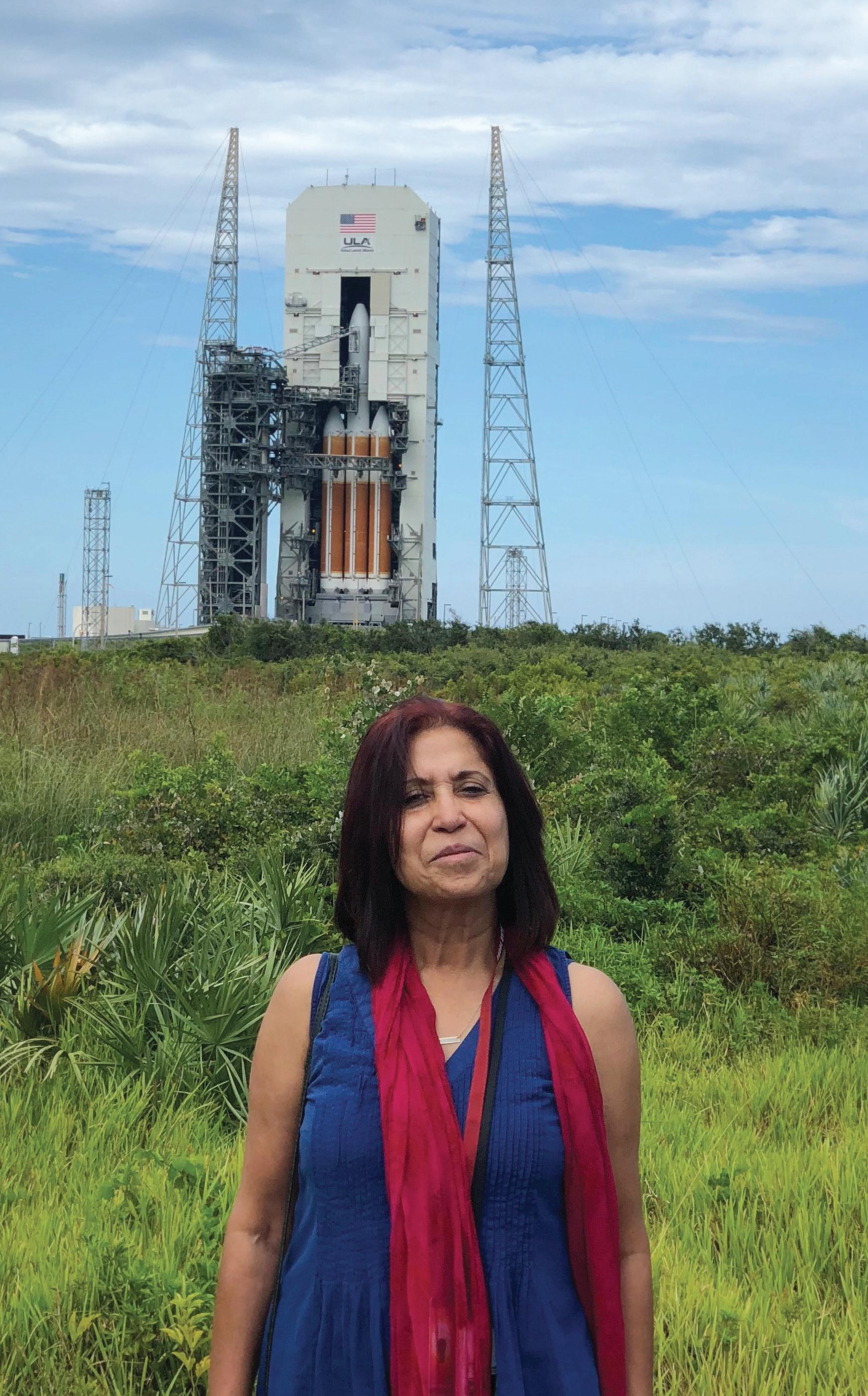
Did you face any challenges as a woman in STEM (science, technology, engineering and math)?

I am uncomfortable saying that I have been discriminated against as a woman. Most of my life, I did not actively think about this, neither did I have time to observe it. You need to look, think and pause to know that this is happening. In the last several years, things have changed. It’s not just NASA, but the whole country: America is changing. We see that reflection at NASA also, and that is the fact. I do not doubt that there is a lot of unconscious bias in the field of science and everywhere.
But, I believe that the empathetic side of women allows them to develop a larger and deeper understanding of everything, whether running a scientific enterprise, a family or the world.
What is your advice for people who want to build careers in STEM?

I think the STEM fields are unique—the impossible becomes reality on a daily basis.
Make pursuit of science and math fun! With puzzles, games, hands-on activities, visits to the museums and planetarium shows. Be curious about everything in the world around you. Get out of your comfort zone. The toughest part is taking the first step that gets you out of the boundaries you feel comfortable in. Take small steps—put yourself in a new environment, do something that scares you, consider other points of view and ensure that you don’t pick the “safe” choice.

What once appeared vast and unconquerable to a young Indian schoolgirl is now the routine of my daily life.Right: Madhulika Guhathakurta in front of the Parker Solar Probe before its launch in August 2018. Courtesy Madhulika Guhathakurta
In December 2022, U.S. Consul General Chennai Judith Ravin launched an exhibit of a full-scale model of NASA’s (National Aeronautics and Space Administration) Mars Rover Opportunity at the American Center.


Built by Cornell University students, the full-scale model was previously on display at the Smithsonian’s Air and Space Museum in Washington, D.C. and at the U.S. Pavilion during the 2020 World Expo in Dubai. The temporary interactive exhibit, which was open through January 2023, included activities built around the Mars Rover and space exploration.
NASA’s Opportunity was launched in 2003 and landed on Mars in 2004
with the goal of searching for evidence that water once existed on the planet’s surface. The Opportunity made several key discoveries during its mission, including evidence of the previous existence of water on Mars and conditions at that time could have been suitable for sustaining microbial life. The rover explored the Martian terrain for almost 15 years, far outlasting her planned 90-day mission. “In 1970—52 years ago—here in Chennai people were talking about moon rocks and lunar exploration and hoping to inspire young generations of Indians to understand more about the MoonEarth system…” Consul

General Ravin said. “Today, you are here to see the Mars Rover, renowned for its planetary exploration…The technologies developed in support of space exploration have real-world applications that affect all of us, from advancements in telecommunications and satellite navigation to agricultural monitoring and weather forecasting.”
The Consul General added: “Our U.S. and Indian scientists and engineers have an opportunity to work together to change the world…We hope that the ties between our two countries in the space sector, including between NASA and ISRO, will continue to expand with future missions to Mars and beyond.”
Top: A cropped version of a 360-degree panorama taken by the Opportunity rover from May 13 through June 10, 2018. This is the last panorama ` acquired before the solar-powered rover succumbed to a global Martian dust storm. Left: U.S. Consul General Chennai Judith Ravin (front left) and U.S. FulbrightNehru Scholar to India Venkateswaran Narayanaswamy (front right) at the launch of the exhibit of a full-scale Mars Rover model in Chennai. By STEVE FOX
By STEVE FOX
As India’s national animal, the tiger has long been a focus of conservationists. In spite of rapid urbanization, poaching and human-animal conflicts, the tiger population has more than doubled in the country. From 1,411 tigers during the first tiger census in 2006 to 2,967 in 2018, the Wildlife Institute of India has recorded an approximately 6 percent per annum increase in tiger population over the years.

Most of the world’s tigers—75 percent of the total number of tigers by Indian government estimates— live in India, making it a key player in global efforts to protect the species. India has 53 tiger reserves, which are connected to other tiger-safe habitats through wildlife corridors. These corridors are protected natural thoroughfares that enable the big cats and other animals to move from one habitat to another.
While these corridors are vital to the continued survival and growth of India’s tiger population, they must coexist with the lives and livelihoods of local people and also acknowledge other demands on the land they occupy. Finding an appropriate balance between conservation and development was the overall goal of a collaborative U.S.-India study led by researchers at New York City-based Columbia University and the Network for Conserving Central India (NCCI), where the idea for the study originated. Published in 2022, this study was based on five previously published studies on tiger connectivity in central India.

“Corridors ensure that a species, like the tiger, can maintain healthy and genetically-diverse populations,” says Jay Schoen, a Ph.D. candidate at Columbia University’s Ecology and Evolutionary Biology Program and a co-author of the study.
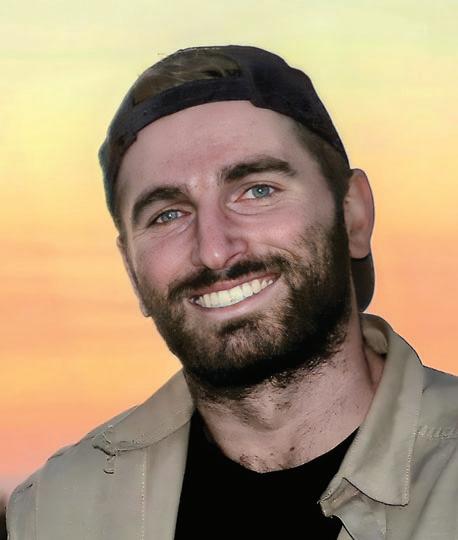
 Left to right: Uma Ramakrishnan of the National Centre for Biological Sciences, Amrita Neelakantan of the Network for Conserving Central India and Jay Schoen, a Ph.D. candidate at Columbia University.
Left to right: Uma Ramakrishnan of the National Centre for Biological Sciences, Amrita Neelakantan of the Network for Conserving Central India and Jay Schoen, a Ph.D. candidate at Columbia University.
U.S. and Indian researchers study ways to protect wildlife corridors allowing tigers mobility to survive and thrive.
Forests and humans share a unique relationship. “In India, forests cover around 25 percent of the geographical area of the country and there are roughly around 300 million people who depend on forests directly or indirectly for their livelihood,” says Varghese Paul, forestry specialist and deputy director, General Development Office, at the U.S. Agency for International Development (USAID) in New Delhi. In addition, “forests provide habitat for endangered wildlife and critically important species like tigers and rhinos.”
People rely on forests for timber, medicinal plants and often bring their cattle to graze. “This degrades forests leading to negative impacts,” says Paul. If forests are managed better, they can pull more carbon out of the air, increase water yields, and improve livelihoods for indigenous and tribal communities.

“Forests are important from an ecological, climate change and socioeconomic and livelihood perspective in India,” says Paul. However, managing this resource “can be a labor-intensive task and must be done holistically, taking into consideration various aspects of the role forests play environmentally as well as culturally,” he explains.
To help improve the management of forests, USAID and India’s Ministry of Environment, Forest and Climate Change launched ForestPLUS 2.0 as a five-year program in three forest divisions—Medak in Telangana, Gaya in Bihar and Thiruvananthapuram in Kerala. The program uses a variety of tools and livelihood interventions to enhance forest management and engage local communities.
One important tool is Van, an integrated system for collection of forest inventory and ecosystem data through a mobile app and automation of data analysis through a web portal. The Van system uses satellite images and geo-analytics to improve forest management and to collect data that is uploaded to a cloud-based data repository. The data analyzed informs forest management projects.
The efficiency and utility of the Van system has been established in Gaya, Medak and Thiruvananthapuram, where it has not only increased the accuracy of data collection but has also significantly decreased the time and effort required for collecting and analyzing data. According to D. Tejasvini, beat forest officer, Medak Forest Division, the introduction of the Van system has not only helped increase her productivity, it has also reduced the time spent on data collection by almost 60 percent. The pre-listed customized information related to the Division has proved very helpful for Tejasvini while filling up the forms in the field.

In Gaya too, the Van system has provided valuable technical assistance to officials and ensured a stronger ecosystem-based management of forest landscapes. Van, along with a forest monitoring tool developed by Forest-PLUS 2.0, plays a vital role in protecting forest land from deterioration by providing reliable data via remote

sensing instead of relying solely on field visits. “Right now, officers have been trained and we are updating our computer servers to store the data,” says S. Sudhakar, conservator of forest at the Gaya Forest Circle in Bihar. “The Van system is being used to develop forest working plans covering 2 million hectares of forests in Kerala, Telangana and Bihar,” says Mark Tegenfeldt, director, General Development Office, USAID/India. He further explains that “the implementation of these plans will help reduce greenhouse gas emissions, increase carbon sequestration, improve water flows from forests and conserve biodiversity.”
Increasing economic opportunities for local communities is also an important aspect of the Forest-PLUS 2.0 program. “Ecotourism projects have been implemented in the Dungeshwari and Barabar hills,” says Sudhakar. Other livelihood interventions include moringa value chain products and the manufacture of incense sticks from recycled flowers from the Mahabodhi and Vishnupad temples. “Flowers are solid waste which is now being managed efficiently to make various products that are being sold by the joint forest management committees,” he says. Wild honey and pickles are manufactured as well. This will be upscaled and sold through outlets in Bodh Gaya where tourists will be major customers. “We are now in the pilot stage and plan to work toward commercialization,” says Sudhakar. “As we scale up, community employment opportunities will also increase.” However, future challenges may involve finding new platforms for the products. “Selling them on an online market may help increase demand and expand our customer base,” he says.
Developmental programs like these help forest officers work closely with village communities. This, in turn, helps create an understanding through which they can address issues like human-wildlife conflict more comprehensively, Sudhakar adds. The discussions and training facilitated by the Forest-PLUS 2.0 team helped them understand the program’s aims and objectives. “We work with a few forest committees who are currently very active and we plan on increasing outreach in the future,” says Sudhakar. “We regularly celebrate the Van Mahotsav forest festivals, meet with local committees, host film screenings on environmental issues and distribute information pamphlets on forest initiatives.”
Sudhakar’s aim as a forest officer is to get more such committees involved in a variety of activities. “We would like to replicate the Gaya model in the forest divisions of Rohtas and Kaimur,” he says. This way, Forest-PLUS 2.0 can target forested areas and scale up forest management efficiency with those who depend on them most.
“Species can only survive in small pockets for so long before the detrimental effects of inbreeding and the loss of genetic diversity render them unlikely to survive long-term. By promoting and restoring natural connectivity between populations—the way tigers existed for millions of years—we can give them the opportunity to continue exchanging genes between core protected areas, thus keeping healthy levels of genetic diversity in the population.”
Amrita Neelakantan, coordinator at NCCI, Uma Ramakrishnan of the National Centre for Biological Sciences in Bengaluru and Schoen worked with other researchers to synthesize the results of five studies of tiger connectivity in central India, where humans and wildlife live in close proximity. Understanding these corridors is essential to better inform local populations, commercial developers, land managers and government officials, and to promote healthy coexistence between people and nature.
Many of India’s tigers live in its central region, a densely populated area encompassing protected reserves, forest patches, farms, villages and cities. It is also a globally recognized priority landscape for tiger conservation. With both the population and infrastructure projects in the area expanding, tiger conservationists must win the support and approval of local residents whose livelihoods rely on small-scale agriculture, cattle rearing and collection of forest products.
“Rural central India is changing. As livelihoods become more commercial, the relationships with wildlife and tolerance of losses to wildlife also change,” says Neelakantan. “Modern conservation tools rooted in understanding the challenges of local people are an exciting path forward. We hope to aid bottom-up approaches to restoration, enhanced livelihood options and other avenues where humans and wildlife interact in safer ways for all
Right: The study involved synthesizing results of five studies of tiger connectivity in central India, where many of India’s tigers live. Understanding these corridors is key to inform local populations, commercial developers, land managers and government officials.





involved.”
Recognizing that groups affected by wildlife corridors may have different—and sometimes conflicting—priorities, the researchers stressed that multiple viewpoints should be considered in reaching decisions concerning corridors.
They explain that conservation efforts focused on tigers have multiple benefits that go beyond one species. “Conserving large areas required by tigers will also conserve space for other plants, animals and microbes, which are all critical to healthy natural processes that people and wildlife depend on,” says Schoen.
“The primary goal of this study was to discern a clear message from the latest research on how tigers are moving between core populations in central India,” he says. “This message was meant for those responsible for land-use decisions in this landscape as well as those impacted by these decisions, so that the many stakeholders involved can find amenable, scientifically informed solutions for nature and humans.”
India’s success in preserving and growing its tiger population is an example for conservationists everywhere, Ramakrishnan notes. “India is such a fascinating and complex place,” she says. “That these large and dangerous carnivores can survive, and thrive here, cheek-to-jowl with so many people, is just amazing. The conservation success of tigers in India is a beacon of hope for conservation and recovery for all endangered species.”
Steve Fox is a freelance writer, former newspaper publisher and reporter based in Ventura, California.
Zwilling330/iStock/Getty ImagesA California company’s aromatic single-origin spices promote sustainability as well as understanding about Indian cooking and culture.

Below: Diaspora Co.,

ragati turmeric, Bindu black mustard and Nandini coriander—for Sana Javeri Kadri, these and other distinctive South Asian spices are more than just delicious powders for flavoring foods.
Instead, Kadri sees the world of spices as an opportunity for exciting international business.
Kadri is the founder and CEO of Diaspora Co., a California-headquartered company that works directly with farmers to share delicious spices with consumers across the United States and beyond.
Diaspora Co. specializes in selling spices that are grown without harmful chemicals, and the company prides itself on carefully testing each harvest for contamination before the spices go to market.
Its spices are also “single-origin,” which means that all of the coriander, chili or mustard contained in a Diaspora Co. package came from the same farm. Sourcing spices this way helps Kadri and her team make sure the quality of each spice is high, and that farmers are paid fairly for their work. During her annual trips to India, Kadri personally visits every farm the company works with to build relationships with farmers. She also works closely with them on the business of their farms and helps them find ways to grow their spices without pesticides.
“Sana provides a much larger profit margin,” Zeinorin Angkang, who grows Sivathei chili in Manipur for Diaspora Co., said in a 2021 Vogue magazine article. “And she pays us all at once. She
also embraces indigenous farming practices like planting yam, soy and rice among the chilies.”
Diaspora Co. sources its spices from across India. Kashmiri chili and saffron come from the north while India’s eastern areas offer Sivathei chili, Naga Hills hibiscus and more. Bindu black mustard comes from the country’s central region, Baraka cardamom from the south, and Nandini coriander from the west.

Its efforts have gained international attention and widespread praise. Food & Wine wrote about Diaspora Co., “Compared to the turmeric you get in the grocery store, it’s night and day. You need to know about this organically-farmed, single-origin turmeric.” In Vogue magazine, Tamar Adler wrote, “Diaspora Co.’s Pragati turmeric is so fragrant it’s almost intoxicating. The Aranya pepper smells like ripe fruit and tastes like smoke, chocolate and mandarins.” Diana Tsui, a reviewer for the food website The Infatuation, wrote, “The difference between these spices and the random ones I used to buy on the shelves at the supermarket is pretty drastic. The flavors are definitely sharper and more like the plants they came from.”
Kadri tells SPAN that critical recognition is always thrilling to see, and that the company wouldn’t be where it is without such positive publicity—but that widespread recognition of the company’s accomplishments has a deeper significance as well. “Now, we see ourselves as translators of culture, as educators and spokespersons for South Asia’s best regenerative farmers, which is all in the service of our mission,” she says. “More visibility means more spices means better, more impactful service to our farmers, and that’s our North Star.”
Kadri was born and raised in Mumbai. In 2012, she moved to the United States to enroll at California’s Pomona College, where she studied food and visual art. Four years later, while working in food marketing for a San Franciscobased grocery store, Kadri took note of the growing popularity of turmeric in American food culture—particularly as an ingredient in popular coffee drinks. She also noticed how the turmeric she tasted in the United States was far less
founded by Sana Javeri Kadri (left), works directly with farmers to share delicious spices, like Pahadi Pink Garlic, with consumers across the United States and beyond.aromatic and intense than what she remembered from Mumbai. Curious to learn more, Kadri decided to return to India. She spent months visiting Indian farms, and spoke with the Indian Institute of Spices Research in Kerala, a meeting she describes as life-changing. She founded Diaspora Co. in 2017 with only one product—Pragati turmeric—which she sourced from a single farm partner named Prabhu Kasaraneni. “The big, audacious dream was to grow a radically new, decidedly delicious and truly equitable spice trade,” Kadri writes.
Diaspora Co.’s growth and international success speak for themselves. Today, the company has expanded into a team of over a dozen employees from India, the United States, the United Kingdom and Saudi Arabia. They sell dozens of spices from over 150 farms. The company’s emphasis on sustainable and organic agriculture, and direct connections with farmers, cuts down on chemical pollution and greenhouse emissions normally associated with the spice industry. And Diaspora Co.’s growing popularity in the United States—which is the world’s biggest consumer and importer of spices—helps spread knowledge and understanding about Indian cooking and culture.
For Kadri, Diaspora Co.’s wide-ranging success all began with knowledge of a fractured past, and dreams of a better future. “Being in this community is about connecting deeply with the culture and heritage of the regions that we source from, and about learning as we go,” she writes on the company’s website.
“Complicating and deepening what ‘Made in South Asia’ means, and how we tell our own stories of freedom, struggle and diaspora through food.”
ice, coffee, pumpkin, mango—the crops India grows are rich and varied. But even the most agriculturally productive countries can benefit from international exchange, and the top-quality ingredients that global cooperation makes available. Just ask India’s chefs.
From crisp American cranberries to richly textured California walnuts, ingredients from the United States have influenced how culinary leaders in India practice their craft. In many situations, Indian chefs incorporate ingredients imported from the United States into traditional Indian dishes, creating new variations of classic themes.
Anoothi Vishal is an author, food historian and columnist who specializes in the culinary ties between communities within India and around the world. “Indian gastronomy has historically been characterized by inventiveness using diverse ingredients, many that came via trade from other regions and cultures,” she says, “and which became deeply entrenched within the country’s strong and deep-rooted culinary cultures.”
American ingredients, Indian style
Below: Diaspora Co.’s organic, single-origin spices have gained international attention and widespread praise.

Michael Gallant is a New York City-based writer, musician and entrepreneur.
Vishal has been using imported cranberries from the United States as a key ingredient in her work. She researches the culinary history of regions around India and uses her knowledge to curate food menus that are both traditional and innovative. Her work includes “exploring how traditional dishes can incorporate the relatively new ingredient of American cranberries, while still retaining taste and nuances that make [the dishes] popular in Indian gastronomy,” she describes. Beloved street food dishes and traditional family recipes from Old Delhi, central India and south India, including ones passed down from Vishal’s own ancestors, have all been reinvented with the cranberry in mind. In late 2021, she curated two chaat festivals at The Leela hotel chain and Punjab Grill outlets
Ingredients imported from the United States inspire Indian chefs to create new variations of traditional dishes.
across India, where traditional chaats (a family of savory snacks) were reimagined to include American cranberries.
Popular American food exports to India include a wide variety of fresh fruits, tree nuts and a variety of prepared foods. “What I love most about American ingredients is the quality of produce, which is amazing,” says Rakhee Vaswani, a celebrity chef, entrepreneur, author and culinary educator in Mumbai. “I’ve worked with Oregon hazelnuts, California prunes, pistachios, California walnuts, Washington apples and poultry, duck and turkey,” she says. “I’ve really appreciated how aware American food providers are when it comes to the source of ingredients, how they’re handled, and even the facilities where they’re processed. From their origin, American ingredients are produced with top-notch quality.”

Many U.S. ingredients are available to Indians via shops and grocery stores, says Vishal. Vaswani regularly sources ingredients from American food suppliers with whom she has forged professional connections. But special efforts are also being made to introduce

further cultural and culinary exchange between the two countries.
In 2021, Vaswani joined then-U.S. Consul General David J. Ranz to conduct a “Taste of America” masterclass hosted by the U.S. Department of Agriculture—Foreign Agricultural Service in Mumbai that focused on the fusion of American ingredients and Indian culinary traditions. The event was held at Vaswani’s Palate Culinary Studio and Academy in Mumbai, and was conducted in front of a live audience. “One dish we prepared together was a new variation of chaat, where we used American cranberries and blueberries to replace dates and tamarind, which are the more traditional ingredients,” she says. “It was a super hit, and looked beautiful. Plus, the dish was full of healthy antioxidants.”
The masterclass fit in with Vaswani’s approach as a teacher and culinary innovator. She runs a culinary school, and the students go into the food industry in India as well as internationally. “Whenever we teach a recipe, we want students to be able to use fresh ingredients and adapt their cooking to wherever they are,” she says. “It’s also my job as a teacher to bind the
ties between countries. I would not want to teach recipes that necessarily use American ingredients in the ways they’re ‘supposed’ to be used in the West.” Vaswani hopes that the food trade between the United States and India continues and grows. “I want the business ties to be stronger between the countries,” she says. “As a chef, experiencing different sorts of produce shows your creativity. There’s a great chain of distributors and suppliers in the United States, each more eager than the other to make sure their ingredients are available in the best form, and I hope that Indian chefs like me can take more and more advantage of that.”
When international food trade flourishes, high-quality ingredients and new inspiration can benefit all involved. “As a food historian, I can say, many U.S. ingredients can successfully be combined with local regional Indian flavors and techniques to present inventive dishes with mass appeal,” says Vishal. “Trade is bilateral. If Indian products and dishes can be popular in multicultural societies like the United States, the reverse is true too.”
Michael Gallant is a New York City-based writer, musician and entrepreneur.Trade is bilateral. If Indian products and dishes can be popular in multicultural societies like the United States, the reverse is true too.





Vaswani incorporates American ingredients in (clockwise from below) broccoli, walnut and cauliflower soup, and millet salad with walnuts and rose; almond barfi with cranberry jam; cakes, and pistachio truffles.

 Rakhee
Rakhee